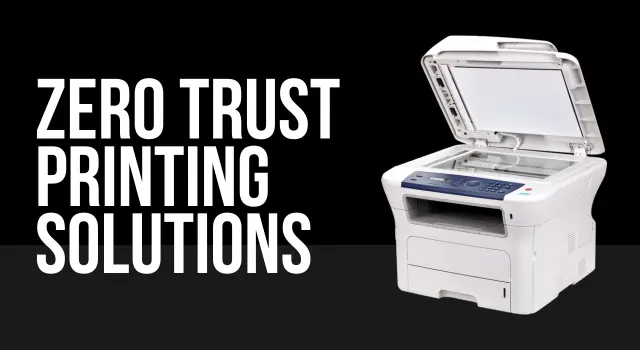
Safeguarding sensitive information has become paramount in today’s digital landscape. One revolutionary approach gaining momentum is Zero Trust Printing, a cutting-edge solution designed to fortify your data security measures. With Zero Trust Printing, organizations can adopt a proactive stance toward protecting their confidential documents and assets.
This article delves into the concept of Zero Trust Printing and its significance in modern cybersecurity practices. It highlights the importance of integrating this innovative solution into your organization’s security framework.
Rise of Zero Trust
Traditional security paradigms must be revised in an era of escalating cyber threats and increasingly sophisticated hacking techniques. This has spurred the rise of Zero-Trust principles, which challenge the conventional notion of trust within network environments. Zero-trust posits that organizations should not automatically trust any internal or external entity attempting to access their systems or data. Instead, every access request must be authenticated and authorized, irrespective of the user’s location or network perimeter.
What is Zero Trust Printing?
Zero Trust Printing extends Zero Trust’s foundational principles to document management and printing infrastructure. It operates on the premise that traditional printing practices are susceptible to security breaches and insider threats. Organizations can mitigate these risks by implementing Zero Trust, which enforces strict access controls, continuous monitoring, and granular permissions for print-related activities.
Why is Zero Trust Printing Important?
The importance of ZT Printing cannot be overstated in today’s cybersecurity landscape. With the proliferation of remote work and cloud-based printing solutions, traditional perimeter-based security measures are no longer sufficient. Zero Trust offers a proactive approach to data security & ensures that only authorized persons can access and print sensitive documents. By adopting this approach, organizations can minimize the risk of data breaches, intellectual property theft, and compliance violations.
The Components of Zero Trust Printing
Zero Trust Printing comprises several key components, each crucial in bolstering the security of printing infrastructure and document workflows. These components include:
1. Always Verify
At the core of Zero Trust is the principle of continuous verification. Users must undergo robust authentication processes before accessing printing resources or initiating print jobs. This involves multifactor authentication, biometric verification, and other advanced authentication methods to ensure the user’s identity and the integrity of the printing environment.
2. Provide Least Privileged Access with Segmentation
Zero Trust Printing promotes the principle of least privilege, in which users are given only the minimum level of access required to do their duties. Organizations can minimize risk of unauthorized access & privilege escalation by segmenting printing resources and adopting user role-based access controls.
3. Assume the Risk of a Breach
Organizations must adopt a proactive stance towards security breaches in line with the Zero Trust philosophy. Instead of relying solely on perimeter defenses, they should assume that breaches will occur and implement measures to detect, contain, & mitigate the impact of such incidents. This involves real-time monitoring, anomaly detection, and rapid incident response capabilities within the printing infrastructure.
How Does Zero Trust Printing Solutions Help in Data Protection?
ZT Printing solutions offer myriad benefits for enhancing data protection within organizations. By integrating advanced authentication mechanisms, encryption protocols, and access controls, these solutions provide a multi-layered defense against unauthorized access and data exfiltration. Additionally, Zero Trust enables organizations to maintain visibility and audit trails of printing activities, thereby facilitating compliance with regulatory requirements and industry standards.
How to Implement Zero Trust Printing?
Implementing Zero Trust requires a comprehensive approach encompassing technological solutions and organizational processes. Key steps in implementing zero-trust printing include:
- Conducting a thorough assessment of existing printing infrastructure and security posture.
- Identifying and prioritizing critical printing workflows and sensitive documents.
- Implementing robust authentication mechanisms, encryption protocols, and access controls.
- Deploying monitoring tools and analytics platforms to track printing activities and detect anomalies.
- Educating employees about the importance of Zero Trust Printing and their role in maintaining data security.

Conclusion
Data breaches and cyber-attacks are rising; organizations must proactively safeguard their sensitive information. Zero Trust Printing offers a forward-thinking approach to data security, ensuring that every print-related activity is subjected to rigorous authentication and authorization processes. As technology continues to evolve, integrating ZT Printing into your organization’s security framework is not just an option but a necessity in safeguarding your most valuable asset—your data.
Frequently Asked Questions
Can Zero Trust Printing be integrated with existing printing infrastructure and software solutions?
Zero-Trust Printing can be integrated with existing printing infrastructure and software solutions through technological solutions and organizational processes. By thoroughly assessing current printing systems, organizations can identify areas for improvement and implement zero-trust principles in a phased approach.
How does Zero Trust Printing address the challenges of remote work and cloud-based printing solutions?
ZT Printing provides a proactive approach to securing remote printing environments by enforcing strict access controls, encryption protocols, and continuous monitoring. Whether employees work from home or access cloud-based printing services, Zero Trust principles protect sensitive documents from unauthorized access and data exfiltration.
What are some common challenges organizations may face when implementing Zero Trust Printing?
Some common challenges organizations may face when implementing zero-trust printing include legacy printing systems that must be compatible with modern security protocols, resistance from employees accustomed to traditional printing practices, and the complexity of integrating zero-trust principles into existing workflows and processes.
What role does encryption play in Zero Trust Printing?
Encryption plays a critical role in ZT Printing by ensuring the confidentiality and integrity of printed documents. By encrypting data at rest and in transit, organizations can protect sensitive data from unauthorized access, interception, and tampering, thereby maintaining the privacy and security of their printing infrastructure.
